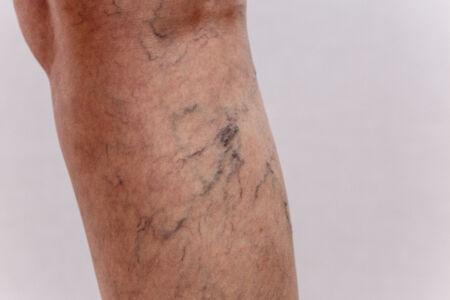
Learn the cause of and what to do about dark & bulging leg veins.
Do you have dark and bulging leg veins? Do you ever wonder if this is more than just a cosmetic problem? If so, the answer is yes. If you start seeing dark, bulging veins in your legs, it's best to get them looked at by a vascular specialist as soon as possible.
Veins that begin to appear twisted and raised above the skin like ropes are clear symptoms of vein disease. These symptoms are a result of faulty valves in your veins cause increased pressure in your legs and will result in the veins protruding above the skin. Often, they're dark purple, blue, and red and can cause the skin to discolor around the veins.
Veins in the legs carry blood back to the heart and tend to be close to the skin's surface, making them appear purple or dark blue. While we think of blood being red, this is because it is enriched by oxygen. After the oxygen has been delivered to other body parts, it turns darker to blue or purple. This darker-colored blood is sent back to the heart.
Other symptoms to be aware of (that you cannot see) are throbbing, aching, or cramping in your legs, along with an uncomfortable and "heavy" feeling. This pain often increases after long periods of sitting or standing. If you start to notice increased pain or swelling, or itching around your veins, this may signal a potentially more serious problem if not immediately addressed.
It has been noted that changes in your hormones caused by menopause, pregnancy, or puberty can result in weight gain, sometimes resulting in prominent and dark veins. These conditions are normal and can change when your hormone levels shift again. Pregnancy can especially take a heavy toll on your veins as it causes your veins to expand due to the significant increase in the volume of blood in expectant mothers.
Aging, in general, can also cause dark veins. Over time your skin will lose elasticity and become thinner, making your veins more pronounced. Drinking alcohol can dilate your veins temporarily, making them more prominent. Noticeable veins can become a permanent condition as a result of chronic drinking. Similarly, long-term tobacco use introduces chemicals into your bloodstream that deprive it of oxygen and cause it to thicken. Thicker blood can pool in your veins, while the lack of oxygen gives it a dark blue hue.
Recent research suggests that your faulty veins can eventually rupture or develop into serious ulcers on your skin. Leg ulcers require more significant treatment to manage. You are also more likely to develop deep vein thrombosis when a blood clot forms in the deeper veins fed by the bulging veins. Blood clots can cause severe leg pain and swelling (though some may not experience any symptoms).
However, if the blood clot breaks away in your vein and travels to your lungs, this is known as a pulmonary embolism, which causes serious chest pain and shortness of breath. Blood clots are a life-threatening condition that requires immediate medical attention. Another common circulatory problem that can result is peripheral artery disease (PAD), wherein narrowed arteries limit the blood flow to the limbs. PAD contributes to leg pain while walking as well as the accumulation of fat deposits in your arteries.
You can take steps to lower your risk of developing dark veins or prevent them from worsening once you get them. These include:
In short, yes, we offer a variety of treatment methods for dark varicose and spider veins, such as:
Endovenous laser therapy: a thin laser filament is inserted into the damaged vein via a small incision in the leg. The laser energy heats the vein from the inside, causing it to collapse.
Sclerotherapy: a solution known as a sclerosing agent is injected into the vein, causing a reaction that seals the vein shut, allowing it to shrink and disappear with time.
Radiofrequency ablation: similar to laser therapy, but instead of laser energy, radiofrequency energy causes the vein to heat and shrink.
Treat your dark veins today and improve the look and feel of your legs!
Center for Vein Restoration (CVR) is America's largest physician-led vein center. You only get one set of legs—trust your leg health with only the nation's leader in diagnosing and treating venous insufficiency (vein disease). REQUEST A CONSULTATION today!